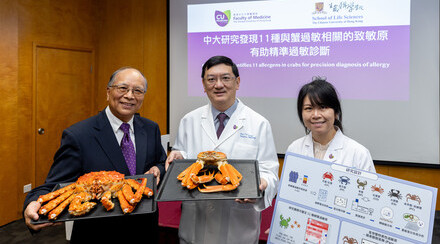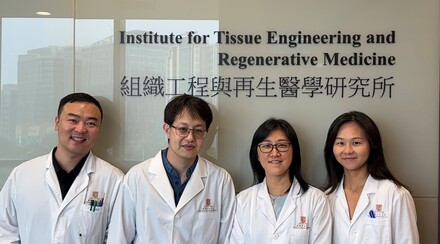CUHK unravels the world’s most comprehensive genome profile of the American cockroach and reveals novel cockroach allergens for the development of precision immunotherapy
The Chinese University of Hong Kong (CUHK)’s Faculty of Medicine (CU Medicine), leading a collaborative international research group involving universities in Shenzhen and Thailand, has recently made a ground-breaking study of the genome sequencing of the American cockroach (Periplaneta americana) that identified more of their allergens. The team unravelled the world’s most comprehensive genome profile for the American cockroach and identified seven novel cockroach allergens on top of the existing 13. The study’s exciting findings lay important foundations for identifying and cloning major cockroach allergens, facilitating the design of effective immunotherapy for cockroach allergy. The results have been published in the international journal Allergy.

CU Medicine’s research team unravels the world’s most comprehensive genome profile for the American cockroach and identifies seven novel cockroach allergens, laying important foundations for identifying and cloning major cockroach allergens, facilitating the design of effective immunotherapy for cockroach allergy.
(From left) Dr Xiong Qing, Postdoctoral Fellow, and Professor Stephen Tsui, Professor, both in the School of Biomedical Sciences; and Professor Leung Ting-fan, Professor in the Department of Paediatrics; at CU Medicine..
Cockroaches account for 45% of sensitisation rate and are the second most common trigger
Allergic diseases, including asthma, allergic rhinitis and eczema, affect over half the population of Hong Kong. Among these allergic individuals, cockroaches account for 45% of the sensitisation rate and are one of the most common triggers, second to dust mites. The degree of cockroach infestation is not only directly related to the incidence of cockroach allergy in inner-city areas, but also responsible for a higher risk of developing asthma and for higher morbidity in asthmatics.
“Although the awareness of the negative impact and significance of cockroach allergy has increased in the last two decades, advances in its diagnosis and treatment are slow owing to the lack of a complete cockroach allergen profile,” remarked Professor Leung Ting-fan, Professor in the Department of Paediatrics at CU Medicine. “A more comprehensive allergen profile could enable component-resolved diagnosis, which is necessary for improving our understanding and precision diagnosis of cockroach allergy.”

Professor Leung Ting-fan
Regarding the treatment of cockroach allergy, Professor Leung said strategies that minimise cockroach exposure remain the key approach. While cockroach immunotherapy may modify the course of asthma, many cockroach-allergic patients exhibit complex sensitisation patterns to multiple cockroach-associated proteins. Due to inadequate knowledge about the full spectrum of cockroach allergens, it is currently difficult to delineate the immunodominant cockroach allergen(s) and produce standardised and potent cockroach allergen extracts for optimal immunotherapeutic treatment.
The research group led by Professor Stephen Tsui Kwok-wing, Professor in the School of Biomedical Sciences at CU Medicine, has been working on the genomics of allergen sources for more than a decade. He has been collaborating with Professor Anchalee Tungtrongchitr, an international expert on cockroach allergy from Thailand’s Mahidol University, on cockroach genomics and allergy since 2018. In this study, they focused on the American cockroach, which possesses a larger genome size compared with the other common allergy-triggering species, the German cockroach.
Identifying seven novel allergens which provide insights for cockroach allergy diagnosis and therapy
Dr Xiong Qing, Postdoctoral Fellow in the School of Biomedical Sciences at CU Medicine, said, “Due to the lack of a high-quality genome, only a limited number of cockroach allergens have been identified in the last 20 years. In this study, we assembled a high-quality, chromosome-level genome with 25 chromosomes in the American cockroach. Based on our research expertise in genomics and allergy, we identified seven more novel allergens on top of the existing 13. We anticipate that this comprehensive profile of cockroach allergens will ultimately benefit the future diagnosis of cockroach allergy.”

Professor Stephen Tsui
Added Professor Stephen Tsui, “Genomics has become a powerful tool for investigating a species of interest. Our genomic results revealed a wide range of gene family variations, such as an important detoxification gene family, glutathione S-transferase, which is highly expanded in the American cockroach genome and explains the high viability of cockroaches. Moreover, our comparative genomics analysis raised the possibility that termites may contain highly identical allergens that are cross-reactive with those of cockroaches. Note that the sudden appearance of swarming termites in flight, generally called ‘flying ants’, on a rainy day in spring or summer is a good indicator that there is a termite infestation nearby. We need to beware of the negative impact from both cockroaches and termites.”
By filling in the gaps of the missing components of the allergen profile, this study provides valuable insights into the development of component-resolved diagnosis and allergen-specific immunotherapy for cockroach-induced allergic diseases. Moreover, the study recommends combining the newly identified allergens with current cockroach extracts. This will facilitate the standardisation of cockroach allergen extracts, benefit risk stratification and thus improve specialist management for individuals who exhibit complex sensitisation patterns.


















































